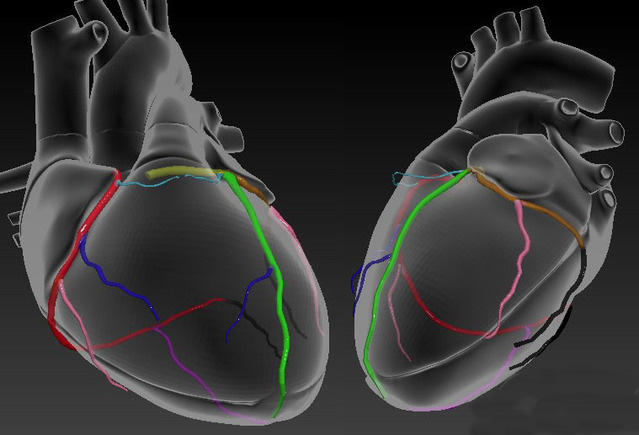Now, we've talked about the direction of flow,
我們介紹了血液流向的問題
we've talked about the fact that one side carries more oxygen than the other,
介紹了動脈血中的氧氣要比靜脈多
and we've also talked about the fact that the arteries are high pressure-low volume system.
同時也講到了動脈是高血壓,低血量的
And the veins are high volume-low pressure system.
對應的,靜脈則是低血壓,高血量
So what are some other differences?
還有什么不同點呢?
So, one other difference is that in the arteries, you actually don't have any valves.
還有一點,動脈中,不存在瓣膜
Now --I don't know how to label that to make it super clear,
這個不太好做標記
but let me just find some sort of open spot here,
在一個好標記的地方寫一下
and write number four, there are no valves in the arterial system,
第四個不同點,動脈中沒有瓣膜
whereas on the venous side, you actually do have valves.
而靜脈中存在瓣膜
You have these valves come together
瓣膜就像這樣
actually make it, let me make it very clear, but making the two sides touch.
我們畫成兩邊是接觸的狀態
And the blood kind of goes through like that.
血液就像這樣通過
So you have these valves keep the blood going in the right direction.
這些瓣膜的存在是為了保證血液的正常流動
So that would be the fourth point of difference between the two.
這是動脈和靜脈的第四個不同點
So you have these valves.
就在于瓣膜

And you might get confused, because you think, "well, doesn't the heart also have valves?"
大家可能要問,心臟里不是也有瓣膜嗎?
And it does, the heart also has valves.
心臟中確實是有瓣膜的
But the veins have a different type of valves, and that's actually keep the blood flowing in the right direction
但靜脈中的瓣膜與那個瓣膜是不同的,既然瓣膜的存在
You can imagine that you probably don't even need that on the arterial side,
是為了確保血液流動的方向正確,那么動脈中是不需要瓣膜的
because the pressures are so high, that the blood is forced to go one way.
因為動脈中血壓很高,血液流向只可能向一邊
Or, as in the veins, because it's kind of like a giant lake.
而在靜脈中,就像一大片湖
Water can kind of swirl around and around and around,
湖水中可能存在漩渦
and so it's helpful to have valves keeping going in the right direction.
所以需要瓣膜來確保流向的正確性
So that's the fourth point of difference.
這就是第四個不同點
So now think about the fact that you might have, a break in the arterial system.
下面大家想象這樣一種情況,就是動脈出現了斷裂
So let's say that you have an accident, and you cut an artery --or, a big artery, let's say.
假設有一起事故切斷了大動脈
What would it look like? So if you have a break right here,
那會是什么樣子呢?假設切斷了這里
you would actually have like a fountain of blood, coming out, right there.
血液會噴涌而出,從這里噴出來
Because it's under such high pressure, that it's gonna spew up, right.
因為血壓很高,血液會噴射出來
And so this is basically what it looks like when you actually cut your artery,
一旦切斷動脈,差不多就是這樣
again, because of the fact that it's under such high pressure.
這是因為動脈內血壓過高
And now on the venous side, on the vein side, if you have a break. It looks really different.
而在靜脈中,如果血管切斷,情況是很不一樣的
Because you have --let's say your break is right here,
假設在這里血管出現斷裂
you'd actually get a kind of --a pool of blood, just locally, before it clots off.
在血液結塊之前,可能會出一部分血
Because again, you have a very low pressure.
這是因為血壓很低
So it's just gonna kind of quietly pool and, you might get a bruise right there.
所以流出一部分血之后,可能只會有一個瘀斑而已
But it's really won't look like a fountain of blood.
并不會噴血
And that's actually another final point of difference which,
這是動脈和靜脈的最后一個不同點
really gets back to the high pressure system on the arterial side and the high volume-low pressure system on the venous side.
歸根到底還是因為動脈中血壓高,而靜脈中血壓低











